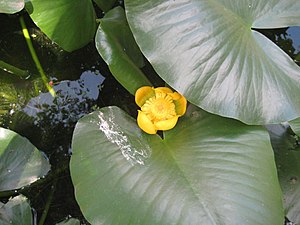Note: This is a project under development. The articles on this wiki are just being initiated and broadly incomplete. You can Help creating new pages.
Difference between revisions of "Nuphar advena - Yellow pond-lily"
(→External Links) |
(→List of Ayurvedic medicine in which the herb is used) |
||
| Line 47: | Line 47: | ||
==List of Ayurvedic medicine in which the herb is used== | ==List of Ayurvedic medicine in which the herb is used== | ||
| − | |||
==Where to get the saplings== | ==Where to get the saplings== | ||
Revision as of 10:41, 11 June 2019
Yellow pond-lily is a species of Nuphar native throughout the eastern United States and at least some parts of Canada, such as Nova Scotia. It is similar to the Eurasian species N. lutea, and is treated as a subspecies of it by some botanists, though differing significantly in genetics.
Contents
- 1 Uses
- 2 Parts Used
- 3 Chemical Composition
- 4 Common names
- 5 Properties
- 6 Habit
- 7 Identification
- 8 List of Ayurvedic medicine in which the herb is used
- 9 Where to get the saplings
- 10 Mode of Propagation
- 11 How to plant/cultivate
- 12 Commonly seen growing in areas
- 13 Photo Gallery
- 14 References
- 15 External Links
Uses
sexual irritability, blood diseases, chills, Curing liver disorders, swellings, inflammations, cuts, Diarrhea, Sore throats
Parts Used
Flowers, Leaves, Stalk, Rhizome.
Chemical Composition
This plant grows in ponds, marshes, and sluggish streams, in most parts of the United States, flowering from June to September; the flowers shut at night and open about sunrise, and the seeds ripen under water.[1]
Common names
| Language | Common name |
|---|---|
| Kannada | |
| Hindi | |
| Malayalam | |
| Tamil | |
| Telugu | |
| Marathi | NA |
| Gujarathi | NA |
| Punjabi | NA |
| Kashmiri | NA |
| Sanskrit | |
| English | Joint Fir, Mormon Tea |
Properties
Reference: Dravya - Substance, Rasa - Taste, Guna - Qualities, Veerya - Potency, Vipaka - Post-digesion effect, Karma - Pharmacological activity, Prabhava - Therepeutics.
Dravya
Rasa
Tikta (Bitter), Kashaya (Astringent)
Guna
Laghu (Light), Ruksha (Dry), Tikshna (Sharp)
Veerya
Ushna (Hot)
Vipaka
Katu (Pungent)
Karma
Kapha, Vata
Prabhava
Habit
Identification
Leaf
| Kind | Shape | Feature |
|---|---|---|
| Simple | elliptic | Submerged leaves roundish and wrinkled |
Flower
| Type | Size | Color and composition | Stamen | More information |
|---|---|---|---|---|
| Unisexual | 4–6 cm | Yellow | 5-20 | The 4–6 yellowish-green sepals are much longer than the petals |
Fruit
| Type | Size | Mass | Appearance | Seeds | More information |
|---|---|---|---|---|---|
| simple | 7–10 mm | clearly grooved lengthwise, Lowest hooked hairs aligned towards crown | many | {{{6}}} |
Other features
List of Ayurvedic medicine in which the herb is used
Where to get the saplings
Mode of Propagation
How to plant/cultivate
A water plant requiring a rich soil and a sunny position[3]
Commonly seen growing in areas
Lakes, ponds, rivers, bays of brackish water.
Photo Gallery
References
External Links
- Ayurvedic Herbs known to be helpful to treat sexual irritability
- Ayurvedic Herbs known to be helpful to treat blood diseases
- Ayurvedic Herbs known to be helpful to treat chills
- Ayurvedic Herbs known to be helpful to treat Curing liver disorders
- Ayurvedic Herbs known to be helpful to treat swellings
- Ayurvedic Herbs known to be helpful to treat inflammations
- Ayurvedic Herbs known to be helpful to treat cuts
- Ayurvedic Herbs known to be helpful to treat Diarrhea
- Ayurvedic Herbs known to be helpful to treat Sore throats
- Herbs with Flowers used in medicine
- Herbs with Leaves used in medicine
- Herbs with Stalk used in medicine
- Herbs with Rhizome used in medicine
- Herbs with common name in English
- Habit - Herb
- Index of Plants which can be propagated by Seeds
- Index of Plants which can be propagated by Cuttings
- Herbs that are commonly seen in the region of Lakes
- Herbs that are commonly seen in the region of ponds
- Herbs that are commonly seen in the region of rivers
- Herbs that are commonly seen in the region of bays of brackish water
- Herbs
- Ayurvedic herbs that don't have seed photos
- Nymphaeaceae




